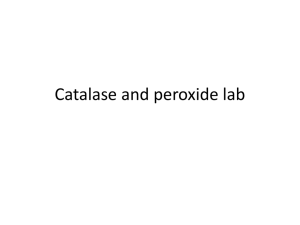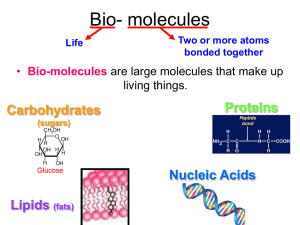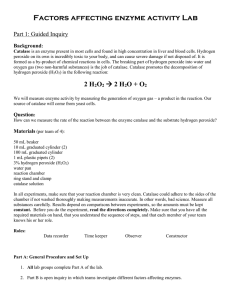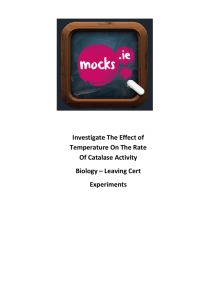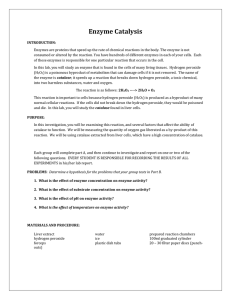Enzyme Lab
advertisement
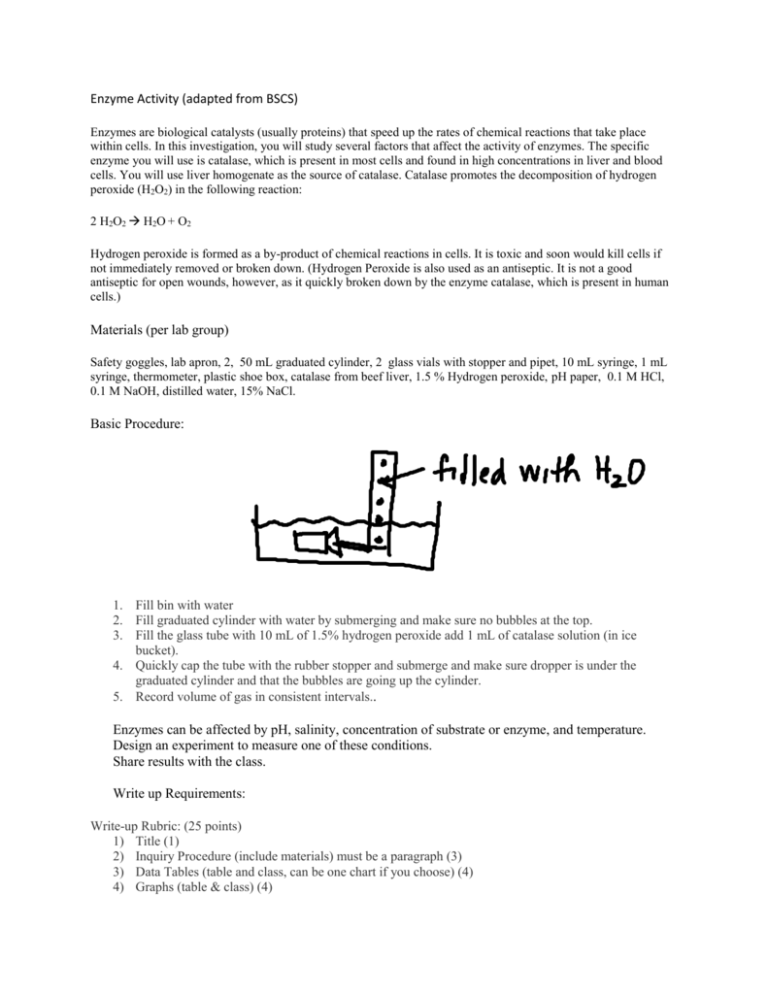
Enzyme Activity (adapted from BSCS) Enzymes are biological catalysts (usually proteins) that speed up the rates of chemical reactions that take place within cells. In this investigation, you will study several factors that affect the activity of enzymes. The specific enzyme you will use is catalase, which is present in most cells and found in high concentrations in liver and blood cells. You will use liver homogenate as the source of catalase. Catalase promotes the decomposition of hydrogen peroxide (H2O2) in the following reaction: 2 H2O2 H2O + O2 Hydrogen peroxide is formed as a by-product of chemical reactions in cells. It is toxic and soon would kill cells if not immediately removed or broken down. (Hydrogen Peroxide is also used as an antiseptic. It is not a good antiseptic for open wounds, however, as it quickly broken down by the enzyme catalase, which is present in human cells.) Materials (per lab group) Safety goggles, lab apron, 2, 50 mL graduated cylinder, 2 glass vials with stopper and pipet, 10 mL syringe, 1 mL syringe, thermometer, plastic shoe box, catalase from beef liver, 1.5 % Hydrogen peroxide, pH paper, 0.1 M HCl, 0.1 M NaOH, distilled water, 15% NaCl. Basic Procedure: 1. Fill bin with water 2. Fill graduated cylinder with water by submerging and make sure no bubbles at the top. 3. Fill the glass tube with 10 mL of 1.5% hydrogen peroxide add 1 mL of catalase solution (in ice bucket). 4. Quickly cap the tube with the rubber stopper and submerge and make sure dropper is under the graduated cylinder and that the bubbles are going up the cylinder. 5. Record volume of gas in consistent intervals.. Enzymes can be affected by pH, salinity, concentration of substrate or enzyme, and temperature. Design an experiment to measure one of these conditions. Share results with the class. Write up Requirements: Write-up Rubric: (25 points) 1) Title (1) 2) Inquiry Procedure (include materials) must be a paragraph (3) 3) Data Tables (table and class, can be one chart if you choose) (4) 4) Graphs (table & class) (4) Note: best to use a “logarithmic” for the trendline, should give you higher R2 values. Solve for rate by taking the coefficient of the “ln” and dividing by any “x” value (time), pick the point on the trendline that is at the steepest rise. Example: y = 4.9844ln(x) + 4.5313 R² = 0.9902 4.9844 / 2 minutes = 2.49 mL of oxygen/minute (remember to round to nearest hundredth place) 5) Power Conclusion (don’t forget citations) (6) https://docs.google.com/document/pub?id=1L3bwXf5AYMMPSzjdauLLx45haI06295I1000plllG8E Don’t forget to include in your discussion ALL the various ways the class found to affect the rate of reaction (concentration, pH, salinity, temperature). Use data (statistics, rate) to support your conclusions. (And no pronouns after all, the enzyme did all the work). 6) Additional Research: (1-2 paragraphs don’t forget citations) on ONE of the following topics: (5) a. Argue pro or con for the use of fever reducers (e.g. aspirin, Tylenol, ibuprofen, etc.) using what you have learned about enzyme function in this lab activity. b. Describe an organism that requires enzymes that can function in extreme conditions (Yellowstone Hot Springs, Arctic or Antarctica, Uranium mine, etc.) using what you have learned about enzyme function in this lab activity. c. Describe how catalase is important in keeping (cellular homeostasis) the cell healthy. d. In the last 2 decades soap companies (laundry and dish detergents) have included enzymes in the detergents. What is the function of those enzymes? Elaborate on one enzyme and it’s function. e. Describe one enzyme of your choice and its function in ANY commercial application (used by a company for profit). (7) References APA www.bibme.org (2)



